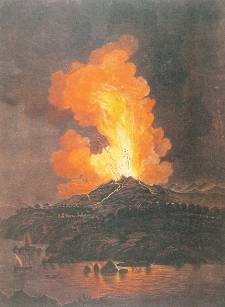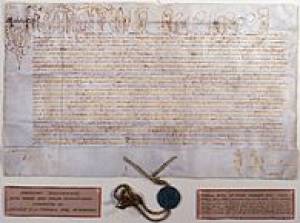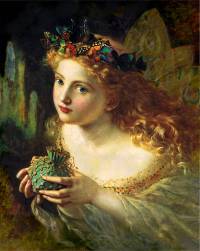The Faerie
Arrival and the Pact of Charlemagne

It was the Summer Solstice, in the year of our lord eight hundred and eleven, when the mountain blew. We wondered what we had done to anger God such that he would visit his wrath on us, but it soon became apparent that this eruption was different from any before or since. Shifting forms poured down the mountain side like living fire, slowly taking on the shape of men, horses, distorted and nightmarish. Behind them came demons, nightmares given form. We watched as the fair folk battled the beasts and won. Then the fair folk turned to us and smiled, their teeth pointed and suddenly I knew: they were the real demons. We ran to the harbour and sailed straight out to sea; we never saw those left behind again, though there are those who swear they have seen the visage of their loved ones on the face of one of the faerie after Charlemagne tamed them.
The Fae came into the world roughly 375 years ago. Following a brief campaign of terror, they were eventually brought to heel by Charlemagne at the Battle of Montgenèvre, high in the Alps. He forced upon them the Pact of Charlemagne; although the exact wording is lost, it is generally assumed to have dictated the following terms:
- The Fae must swear loyalty to the Holy Roman Emperor
- The Fae must either become vassals of a Human Lord, or become vassals of God through entry into the Church.
Since the signing of the Pact, the thousand or so Fae have integrated into the European courts as nobility, vassals inherited from lord to heir back through the centuries. Many have become trusted advisers to their lords, also acting as deadly knights or feared battle magicians in times of conflict. Many are openly distrustful of the Fae, despite the papal decrees granting them divine sanction.
Papal Bull, Nympharum Anima
 Papa Lucia, episcopus servus servorum Dei, Nympharum anima gloriae Caelum facere participem.
Papa Lucia, episcopus servus servorum Dei, Nympharum anima gloriae Caelum facere participem.
It has been revealed as Truth that the Fae have souls and may be raised unto Heaven.
As such they shall serve in the Church, though they are not to rise to the highest ranks until God permits.
However, they are not created in the same image of God as ourselves, and so may not enter into matrimony with any but their own kind.
Ego N. Catholicae Ecclesiae Episcopus
Upon receiving news of Charlemagne's victory, Pope Lucia issued the above bull. It was not long after that she was deposed following allegations of corruption, and many still dispute the validity of the bull, despite confirmation from her successor that it was valid. Foremost among the dissenters are the Inquisition, who maintain that Fae are agents of corruption and Pope Lucia was a false pope. The upshot is:
- Fae are deemed to have souls, and can go to Heaven under the same terms as Humans.
- Fae may become priests, but may not rise to the rank of Cardinal or Pope.
- Fae may not marry Humans.
The Unseelie
The Fae refer to themselves as collectively as The Seelie Court, though there are many Fae courts and many outsiders and the exact meaning of this term is unclear. Those who ask (and bribe) Fae friends into revealing more are told whispered tales of something called The Unseelie Court, apparently a collection of the most mischievious or destructive Fae working to bring down the Seelie, humanity, and the gods of any religion.
There are many destructive and evil Fae in the Wilds, but nothing has yet been found either large enough or malevolent enough to warrant the terror in the voices of even the strongest Fae when she speaks of the Unseelie Court.
Common Perceptions of the Fae
 Myths abound concerning the faerie, and vary from region to region, and potentially relate only to specific Fae. However, common aspects almost universally agreed on are:
Myths abound concerning the faerie, and vary from region to region, and potentially relate only to specific Fae. However, common aspects almost universally agreed on are:
- The Fae are creatures of their word. To break a contract is unthinkable to them. They view oathbreakers as the lowest of the low.
- The Fae are tricky, and deals made with them must be considered carefully.
- The Fae are immortal. They do not die of old age, and are surprisingly resistant to normal weaponry.
- The Fae command vast magical powers of unknown capability.
- The Fae are vulnerable to Cold Iron. Details on the manufacture and utility of cold iron are somewhat sketchy, though all agree this was how Charlemagne beat them.
As most notable Fae have manoeuvred themselves deep within the ranks of the nobility, contact between them and your average inhabitant of Britain is rare, and they are largely treated as other nobility - stay clear and hope for the best. If you have grown up on a large estate you may have known one who was resident as an advisor to the Lord, but you are unlikely to be intimately familiar with them. You may well have seen Brownies, Nixies and other minor Fae, or have caught glimpses of Fae creatures such as Kelpies or Will-o'-the-wisps.
Fae Magic
Knowledge of Fae Magics is hoarded by those who learn such, however there are a number of iconic spells that are described in common tales.
- Dream Walk, the ability to enter the minds of friend of foe as they sleep and watch - or worse, control - their dreams
- Oathbreaker's Lot, the ability to punish someone who has broken a contract through a variety of horrible curses.
- Illusions, fooling foes, hiding friends, disguise, trickery.
- Animalism, the ability to talk to and command animals.
- Astral Projection, the ability to project one's conciousness many miles to spy on your enemies.
- Flash, the ability to travel from one place to another through lightning strikes.
- Battle Magic, varying from shattering a suit of armour with a single touch to dramatic overkill spectaculars such as death by five thousand flaming projectiles or the ultimate Fulminant Sacrifice, capable of levelling entire cities and the armies therein.